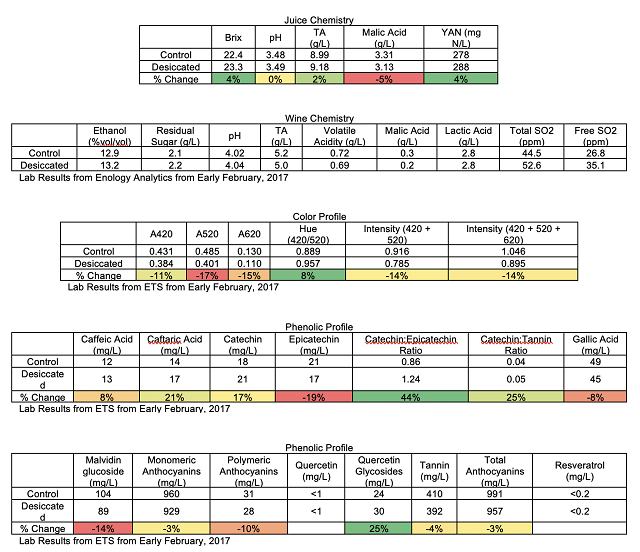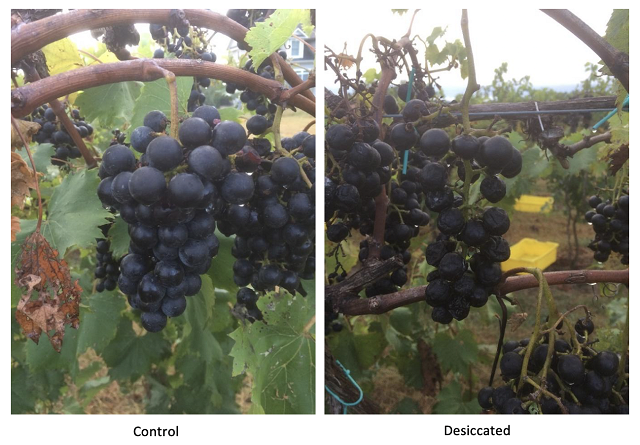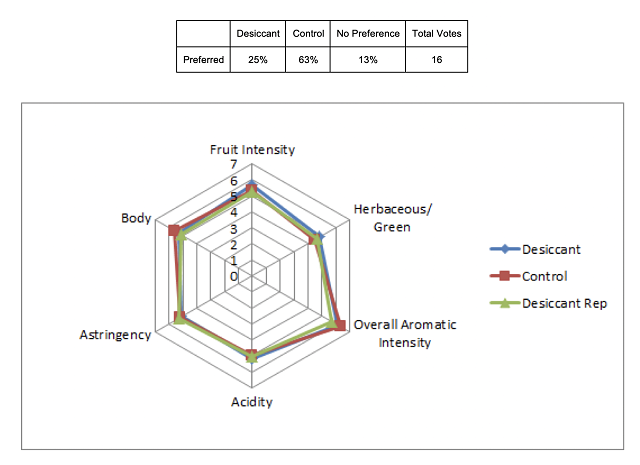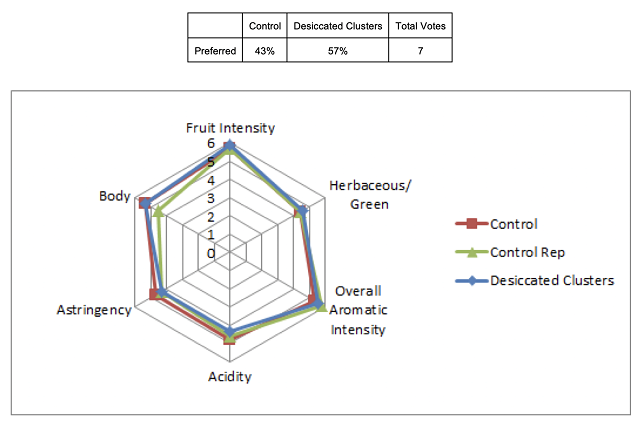The Effect of Desiccation Spray on Ripeness in Chambourcin (2016)
Submitted by Bill and Tremain Hatch
Zephaniah Farm Winery
Summary
This study examines the impact of a desiccation spray on the chemical and sensory profiles of Chambourcin grapes and wine. One block of Chambourcin was divided so that one section of fruit was sprayed with a potassium bicarbonate desiccant, and another section was not sprayed. The desiccated fruit was sprayed at the beginning of veraison and then weekly for a total of four sprays over four weeks. The fruit was harvested and processed on the same day, and all treatments between the fruit were identical. The desiccation treatment slightly concentrated berry components, although not many differences were found in wine. The desiccation treatment, however, lowered the color intensity and slightly lowered the tannin and anthocyanin content in the wine. Other parameters were not greatly affected. At one tasting, the wines were found to be significantly different (p<0.05), and in general there was a preference for the wine made without desiccation. At another tasting, there was no significant difference between wines, and no major preference trends. More studies on desiccation across vintages would be beneficial to further elucidate the impact of these treatments in Virginia.
Introduction
In regions with common rainfall, ripening problems may occur due both to dilution from rain as well as from forced early harvest to avoid excessive disease pressure. As such, crop management techniques provide a key tool to enhance ripening kinetics and reduce disease pressure. One such method for crop management involves crop desiccation. Desiccation naturally concentrates several ripeness factors in grape berries. Crop desiccation occurs naturally in regions with low rainfall, but is generally impeded by rain. A potassium bicarbonate desiccant spray (RG 1950) has been developed which can instigate desiccation in grape berries. This study examines the impact of this desiccant spray on the chemical and sensory qualities of Chambourcin.
Results and Discussion
The desiccation treatment slightly concentrated berry components, although not many differences were found in wine. The desiccation treatment, however, lowered the color intensity and slightly lowered the tannin and anthocyanin content in the wine. Other parameters were not greatly affected.


For the triangle test on March 8, of 30 people who answered, 16 people chose the correct wine (53%), indicating that the wines were significantly different (p<0.05). These wines were voted to have an average degree difference of 4.2 (out of 10), suggesting that the wines were moderately different. In general, people who answered correctly preferred the control treatment to the desiccant (although this was a weak preference). No strong trends were found between wines for the descriptors used in this study.Control Desiccated

For the triangle test on May 31, of 14 people who answered, 7 people chose the correct wine (50%), suggesting that the wines were not significantly different. Of those who answered correctly, there were no major preference trends from one wine over the other. Descriptive analysis did not show any strong trends with the descriptors used in this study.

More studies on desiccation across vintages would be beneficial to further elucidate the impact of these treatments in Virginia.
Methods
One block (1.3 acre Haverty Vineyard in Aldie, VA) of Chambourcin cropped at 4.7 tons per acre was divided so that approximately one section of fruit was sprayed with a potassium bicarbonate desiccant (RG 1950), and another one section was not sprayed. In the field, there were two geographical replications of desiccated fruit, and two geographical replications of control fruit. The desiccant was sprayed 4 times beginning at veraison and then weekly for a total of 4 sprays over 4 weeks. The spray rate was two packages per application, focused on the fruiting zone. Each package was 334g, so the application rate was 7.36 pounds per acre per application, for a total of 29.45 pounds per acre for the season. This application was only performed on the fruiting zone, however, and much more would have been needed had the application been performed on the entire canopy.
6.2 tons of fruit was harvested on 9/27/2016, with 22% of it being desiccated. 50ppm sulfur dioxide was added at crush. A 5% saignée was taken immediately on all lots (juice analysis was taken before saignée). 2 gallons of Hungarian oak dust was added per bin, along with 2 quarts of Hungarian oak chips. Fermentations were inoculated with BM45 the day of crush, rehydrated with Go Ferm. On 9/28, the fermentations were co-inoculated with Beta Co-Inoc. On October 10 both treatments were pressed separately. On October 16 the wines were barreled down with 75ppm sulfur dioxide into 2016 Zemplin Hungarian Oak Barrels. On November 22 48ppm sulfur dioxide was added. All other fermentation and aging practices were identical between lots. Wine was taken for the Research Exchange on January 22.
This project was tasted on March 8 and May 31. For the triangle test and preference analysis, anybody who did not answer the form were removed from consideration for both triangle, degree of difference, and preference. Additionally, anybody who answered the triangle test incorrectly were removed from consideration for degree of difference and preference. Additionally, any data points for preference which did not make sense (such as a person ranking a wine and its replicate at most and least preferred, when they correctly guessed the odd wine) were removed.
In order to balance the data set to perform statistical analysis for descriptive analysis on March 8, any judge who had not fully completed the descriptive analysis ratings were removed. In order to then make the amount of judges between groups equivalent, two judges from group 1 were removed. This resulted in a final data set of 3 groups, each with 9 judges (considered as replications within groups, and groups were considered as assessors). Data was analyzed using Panel Check V1.4.2. Because this is not a truly statistical set-up, any results which are found to be statistically significant (p<0.05) will be denoted as a “strong trend” or a “strong tendency,” as opposed to general trends or tendencies. The statistical significance here will ignore any other significant effects or interactions which may confound the results (such as a statistically significant interaction of Judge x Wine confounding a significant result from Wine alone). The descriptors used in this study were Fruit Intensity, Herbaceous/ Green, Overall Aromatic Intensity, Acidity, Astringency, and Body.
The same procedures for data analysis were used on the May 31 tasting. For the descriptive analysis in this tasting, one judge was eliminated from group 2 and 3 so that each group had three judges, for a total of 9 judges.
